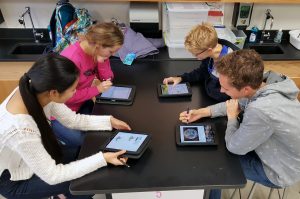JHS Students Dominate in Worldwide Project Green Challenge
Food waste. Styrofoam dishware. Plastic straws. Fast fashion. Freshwater resources. Industrial hemp.
And the list of environmental concerns goes on.
During the month of October, four Johnston High School students dived into the Project Green Challenge, an online call to action for 30 days of environmentally-themed challenges, providing students with mentorship, advocacy, and leadership skills. Junior Angela Cai, junior Sophie VanZee, senior Joseph Haggerty, and senior Libbie Smith participated in Project Green on their own, with advisement from JHS science teacher Kyla Burns.

Johnston students in the Project Green Challege – Angela Cai, Libbie Smith, Sophie Van Zee, and Joseph Haggerty – discuss a posted challenge and divide up responsibilities.
According to the Project Green Challenge website, the goal of the project is, “to touch lives, shift mindsets, and equip students with knowledge, resources and mentorship to lead change that causes a powerful ripple effect on campuses and communities worldwide.”
This intensive foray into environmental science for the four students was an eye-opening experience into the many challenges facing Mother Nature. Their effort – above and beyond any routine classroom assignment – earned them a third place finish among 690 high school and university teams from around the world.
“The earth is our home and I’ve always felt like we should be doing more to protect the environment,” said Haggerty. “I did the Project Green Challenge because environmental advocacy is something I believe in personally.”
Green, Greener, Greenest
Each day during October, multiple challenges were posted to the Project Green website. To earn points, teams had to complete the challenge within the specified time limit. If they completed a level Green challenge, they could then complete a level Greener challenge, up to Greenest. Teams could also earn extra credit for additional work. Students did research, created videos, wrote social media posts, answered questions, built budgets, and other types of hands-on projects in order to give them a full understanding of environmental impact. Each challenge, the students said, took about one hour to complete.
“Taking care of our environment is a community-wide, world-wide thing,” said Van Zee. “As part of some of the challenges, we reached out to different people within the district, city, and even state to learn more about environmental efforts taking place. That allowed us to communicate with people we wouldn’t normally have the chance to interact with, which is pretty cool. Most were helpful and willing to hear our ideas.”
The students used group chat, Skype, and in person meetings to divvy up the responsibilities for each challenge. Burns helped them with the documentation and uploading work to the challenge website.

Angela Cai and Libbie Smith learn more about environmental dangers through the Project Green Challenge.
Sharing Their Knowledge
Now that the team is in the finals, Van Zee will fly to San Francisco the week of November 15 to do an eight-minute presentation to a panel of judges, sharing what the team learned and what efforts they will continue to work on now that the challenge has ended. The grand prize is a $5,000 scholarship (split amongst team members) and an array of product-based prizes.
“This has been a lot of work, but work we all feel passionate about,” said Cai. “The different topics in the challenges helped us educate ourselves on the many viewpoints out there and variety of information made available on products to the consumer.”
As part of their high marks in the Project Green Challenge, the students and Burns were invited to WE Day in Minneapolis, where students gathered to celebrate and promote social change within their communities.
“WE Day isn’t a direct relationship to environmental science, but it was very inspiring to be there and hear the stories of how small groups were able to have an impact in their schools or communities,” said Smith. “I know this type of work is what I want to do with my future and it’s been an incredible opportunity to work on Project Green and learn so much in a short period of time.”